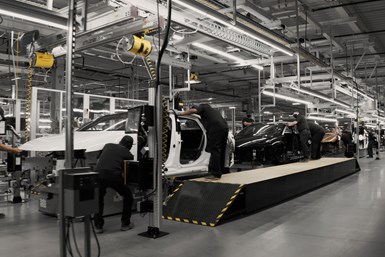Lucid Factory—Phase One—Complete
They’ve built the beta test cars. Now they’re running the factory to test the tooling and equipment
Just like a traditional OEM, Lucid Motors, the developer and soon-to-be manufacturer of electric vehicles, starting with the Lucid Air, is running trial production, testing out the tooling, in its greenfield factory, or as it calls it, the “Lucid AMP-1,” as in “Advanced Manufacturing Plant.”

Inside the Lucid AMP-1, the first phase of the company’s factory in Arizona. (Images: Lucid Motors)
A few interesting aspects:
- This is the first greenfield, dedicated EV plant to be built in North America. GM has retrofitted existing plants for EV production. And the Tesla Fremont, California, factory began its existence in 1962 as a GM assembly plant.
- Groundbreaking on the 590-acre site in Casa Grande, Arizona, occurred on December 2, 2019, and on December 1, 2020, the company has announced it is running cars.

Customer deliveries from the factory are to occur in Spring 2021.
- AMP-1, which is to start series production for Spring 2021 deliveries of the Lucid Air, has an initial annual capacity of 30,000 vehicles per year.
- The production footprint is presently 999,000 square feet. There will be a phased increase in tooling and equipment. It is anticipated that by 2028 the production operations will cover 5.1-million square feet and the annual output will be 400,000 units per year. (In addition to the Lucid Air, a sedan, the company is working on Project Gravity, an SUV that is to launch in 2023.)
Quote
“In building this factory, we adhered to several important manufacturing philosophies, including the tenets of ‘Future Ready’ and ‘On Time,’ together which have allowed us to effectively manage our investment and build a brand new factory from the ground up. As we add new platforms and vehicles to our lineup, the planning that went into this facility ensures that we will always be able to keep up with growing customer demand for advanced electric vehicles,” said Peter Hochholdinger, VP of Manufacturing, Lucid Motors.

Getting closer to launch.
RELATED CONTENT
-
Cobots: 14 Things You Need to Know
What jobs do cobots do well? How is a cobot programmed? What’s the ROI? We asked these questions and more to four of the leading suppliers of cobots.
-
Plastics: The Tortoise and the Hare
Plastic may not be in the news as much as some automotive materials these days, but its gram-by-gram assimilation could accelerate dramatically.
-
Multiple Choices for Light, High-Performance Chassis
How carbon fiber is utilized is as different as the vehicles on which it is used. From full carbon tubs to partial panels to welded steel tube sandwich structures, the only limitation is imagination.


.jpg;width=70;height=70;mode=crop)






